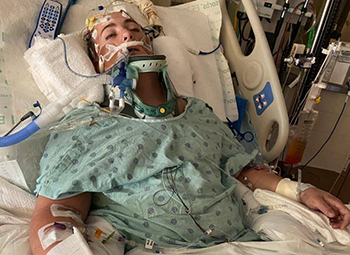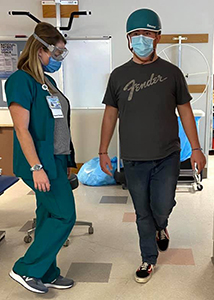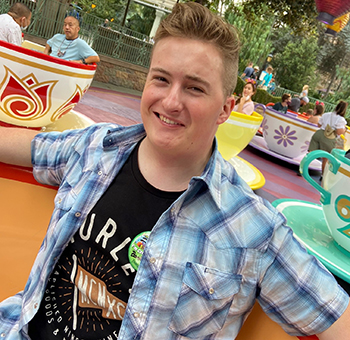A year ago, in August 2020 Rescue, Calif. resident Sharon Benton received the phone call that every mother dreads.
 Kyle Benton was hospitalized for 43 days.
Kyle Benton was hospitalized for 43 days.
Her 18-year-old son Kyle was longboarding with a friend. He was going downhill fast, when he went flying off of his board. The back of his skull hit the pavement and he sustained a fracture, six inches wide. He wasn't wearing a helmet.
His friend called 911 immediately. Paramedics from the El Dorado Hills Fire Department arrived and he was rushed by ambulance to the UC Davis Pediatric Intensive Care Unit (PICU).
The National Safety Council reports that 217,646 people in the United States were treated in hospital emergency rooms for longboarding, skateboarding and hoverboarding injuries in 2020. The majority (more than 81,000) of those injuries occurred in children ages 5 to 14.
'It broke my heart to see him like that'
As a result of his fall, Kyle suffered a traumatic brain injury (TBI), a skull fracture, a subdural hematoma (a buildup of blood on the surface of the brain) and a blood clot in the brain.
— Sharon Benton
As hours passed, more injuries were added to the growing list. He had suffered broken vertebrae. He also had pneumonia, a common complication of severe brain injury.
"When I walked into the doors of this hospital, I had no idea what to expect or when we would be able to bring Kyle home. And, to be honest, if we would be able to bring Kyle home again," said Sharon Benton.
Her first sight of her son in the hospital: Kyle lying still, surrounded by endless cords attached to monitors. A brace propped his neck into place. A ventilator was breathing for him. He was in a medically induced coma.
"It broke my heart to see him like that," Benton said. "But the doctors and nurses were so gifted, compassionate and kind. Our nurses were there for me, cried with me and got me through those difficult days."

Kyle had physical, occupational and speech therapy six days a week while hospitalized.
Kyle would remain in that state for two weeks. During this time, UC Davis neurosurgeon Orin Bloch successfully performed a decompressive craniectomy, a surgery to remove a portion of his skull to relieve the swelling in his brain. Months later, he would have a cranial reconstruction to re-form the part of his skull that was removed.
Then, slowly, his medical team weaned him from the sedatives and pain medicine. It was a daily balancing act to keep him stable and comfortable but progressing forward.
9 safety tips for longboarders
Longboarding is a style of skateboarding, using longboards which usually are 42 to 80 inches long compared to 30- to 38-inch-long skateboards. Longboards are flat and build speed when going downhill.
The American Academy of Pediatrics advises riders of skateboards and longboards to follow these safety precautions:
• Wear a helmet that meets safety standards. Look for a label on the helmet that reads ASTM F1492 or Snell N-94. This means the helmet is specially designed to protect skateboarders, longboarders and roller/inline skaters.
• Wear protective gear: wrist guards, knee and elbow pads, and shoes with flat soles.
• Make sure the wheels and hardware are secure before riding.
• Be aware of speed wobble, when the board moves from side to side unexpectedly and causes the rider to fall off. To prevent it, ride forward on the board and crouch. Longer boards with wheels that are farther apart may be less likely to have speed wobble.
• Check local laws before riding in public. Some cities have rules about where longboards and skateboards can be ridden. Never ride alone or in low light.
• Watch out for holes, rocks and bumpy riding surfaces.
• Never ride under the influence of alcohol or drugs.
• Use community skateboard parks instead of riding on homemade ramps or jumps. The parks are away from motor vehicle traffic, and ramps are monitored for safety.
• Children under age 5 should not ride the boards, and children ages 5-10 should be supervised.
Sharon started an online Facebook group, Prayers for Kyle Benton, to update her family and friends regularly about Kyle's progress. Soon, she had a global following of thousands of people she had never met, who were keeping Kyle and her family in their prayers.
She will forever remember Sept. 11, 2020 as the turning point in Kyle's patient journey. She posted to her Facebook group, "We have seen many changes in Kyle over the last 18 hours. His eyes started fluttering. His arms and legs are moving. They are lowering all meds and respiratory aids. This may take a couple of days, but Kyle is waking up."
On the road to recovery
When Kyle came out of his coma, physical, speech and occupational therapy began in the hospital, six days a week.
"When our rehab team first met Kyle, he was non-verbal, not comprehending much and was fed by a tube," said speech therapist Michelle Ramirez. "Kyle progressed quickly and was very determined and motivated. He was such a pleasure to have in therapy, always willing to do the hard and boring tasks he knew would make him stronger."
Music therapy also helped provided much-needed healing for Kyle. An avid musician who plays both piano and guitar, Kyle was able to receive daily visits from music therapist Tori Steeley. He would play songs with her that he enjoyed.
"The first time I met Kyle, his mom showed me videos of him playing music with his friends. Kyle expressed concern several times during that visit that he didn't remember how to play music," Steeley said. "Music therapy was used to find the ways that Kyle could still positively and easily engage in music-making. We realized that although reading or recalling specific musical pieces was frustrating for him, he easily remembered guitar and piano chords. Music therapy sessions were often spent with Kyle playing Elton John or Beatles songs on guitar and piano, focusing on Kyle's strengths as a musician."
A walking miracle

On the one-year anniversary of his injury, Kyle Benton celebrated at Disneyland with his family.
On Oct. 13, the Benton family got the miracle they were hoping for. After 43 days of hospitalization, Kyle was discharged from the hospital and was able to walk out on his own.
"Kyle's recovery is a testament to his determination, his parents' support and advocacy and his medical team walking alongside him, pushing him each step. We are grateful to be able to see him make his way now to college," Ramirez said.
Kyle recently celebrated his 19th birthday. This week, he will be leaving home for Brigham Young University Idaho, where he will begin his freshman year. These are milestones that the Benton family had dreamed of during Kyle's long battle and recovery.
"We are extremely thankful to everyone who was there to take care of Kyle. From our good friend Stacy Minnich who was one of his first responders, to the medical staff at UC Davis. Together, these people and God saved his life," Benton said. "You have to believe in miracles. That's what Kyle is to us. A walking miracle."






